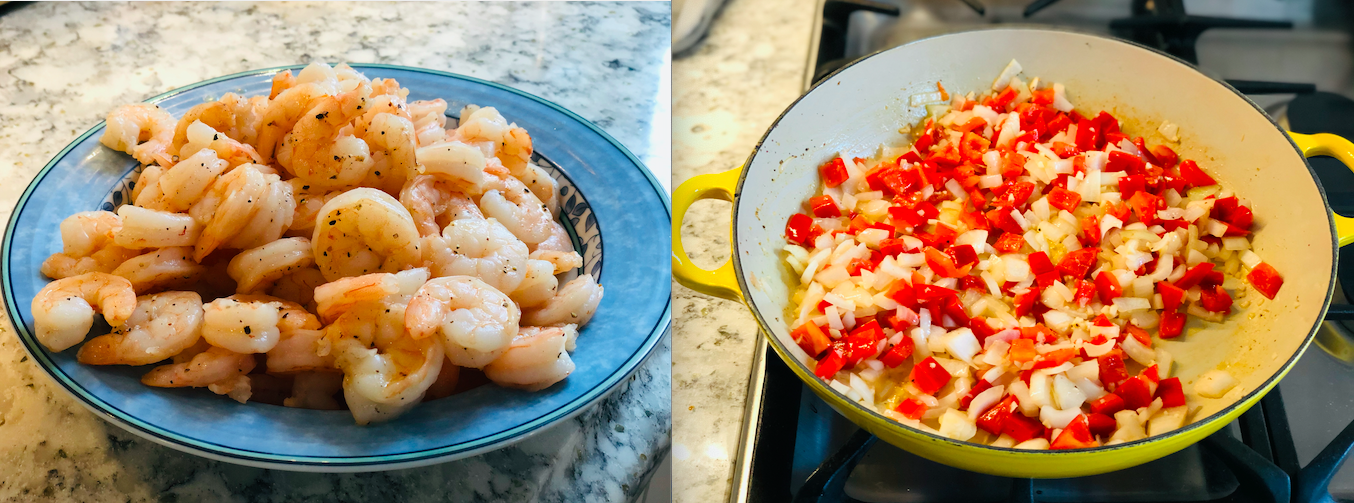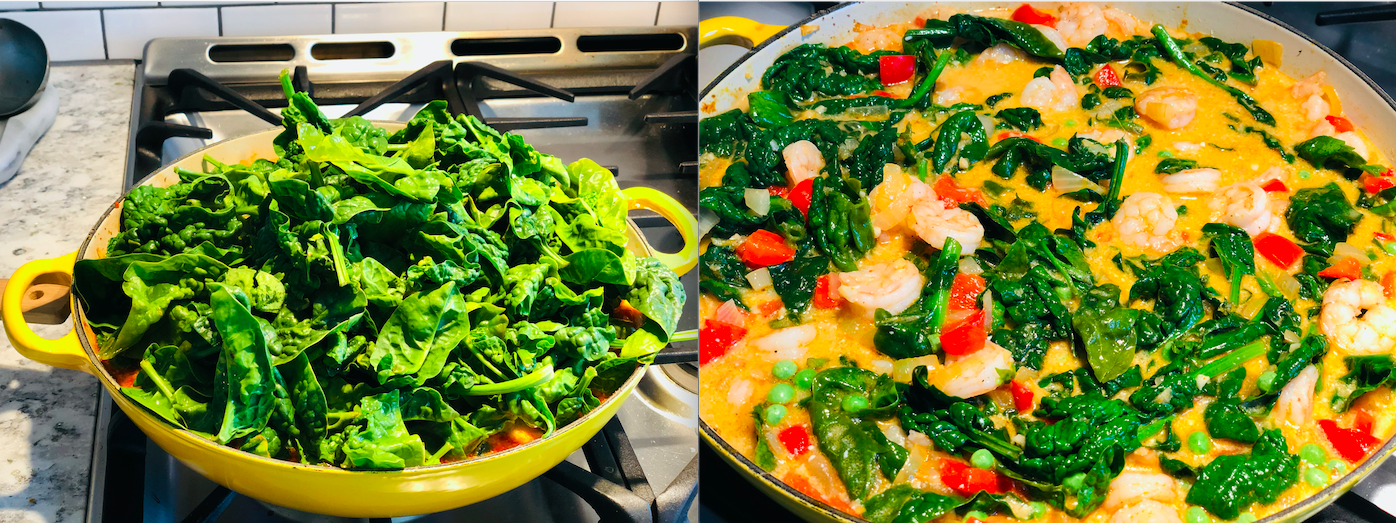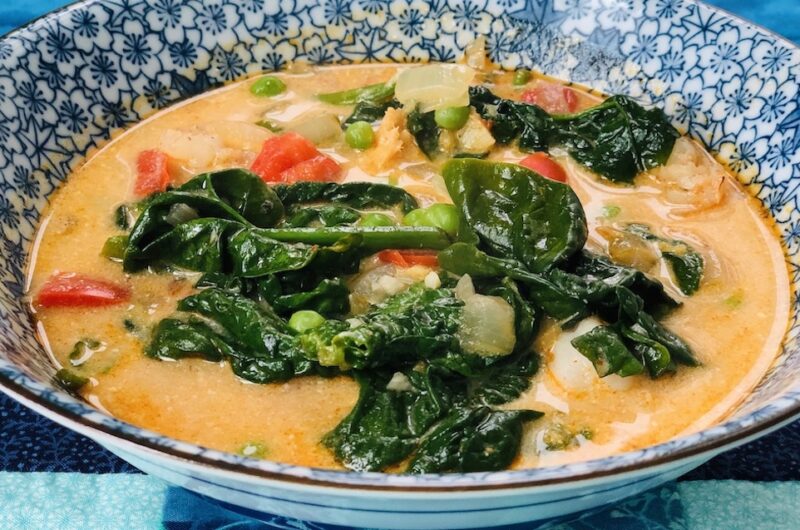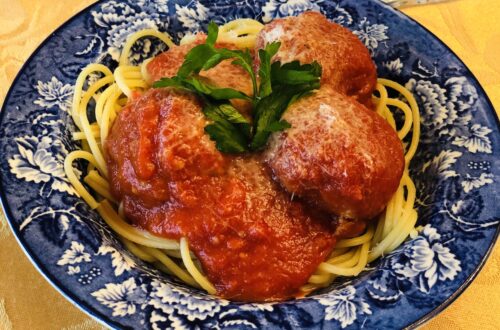
Thai-Inspired Shrimp and Vegetable Soup
I stumbled across this soup during the early days of the pandemic and instantly fell in love with it. I was cooking it while on Zoom with friends one Saturday night when, from off screen, they heard a “yummmmm, wow!” as I stirred and tasted it. Still, even as I was tasting it, I realized it was missing something – vegetables. And so, the spinach and peas made their way into the soup, never to leave. Without these vegetables, it’s a good soup with a warm, rich broth – and shrimp! But with them, it’s a full and filling meal (plus it’s helped to convince my mother that I do, in fact, eat vegetables). Because I was cooking this during the pandemic with limited grocery shopping, I never did add the cilantro. I assume it tastes great here and would certainly add it if I had any.
While I could write about coconut milk or garlic or some other ingredient, for this first post I want to focus on the soup’s focal point: shrimp. I love shrimp. Shrimp with cocktail sauce, in linguine, in soup, really in and with anything and everything. And I’m not alone. On average, Americans eat 4.4 pounds of shrimp per year. Although canned tuna used to be the seafood most eaten by Americans, 2001 shrimp took the lead and has held that title ever since. We often think of shrimp as something fancy and upscale. In reality it has become a staple of the American diet, in large part based on cheap – and often sketchy – imports.
The United States imports 90 percent of its shrimp. 90 percent. Most of this shrimp is farmed and comes from Asia: India, Indonesia, Vietnam, Thailand. While there are numerous issues with imported shrimp – from unsanitary conditions to the use of banned antibiotics to environmental harm, for this first post I am focusing on forced labor issues. (I promise, I cook enough shrimp that I will eventually have time to discuss the other issues.)
According to the U.S. Department of Labor’s 2018 report on forced labor, the shrimp industry across Asia is marred by child and forced labor: there is child labor in the Bangladeshi and Cambodian shrimp industry, forced labor in the Burmese shrimp industry, and both child labor and forced labor in the Thai shrimp industry.
Back in 2015, the Associated Press published number of articles on forced labor in the Thai seafood industry which detailed brutal human rights abuses in shrimp supply chains. At the time, Thailand was a large exporter of shrimp to the United States (the amount of Thai shrimp imported into the US has since decreased). The AP reporters found shrimp sheds where migrant workers – mainly from Burma, Cambodia, and Laos – were forced to work sixteen-hour days peeling shrimp and were not allowed to leave the sheds. Workers recalled being physically abused and having their wages arbitrarily cut. Children were held with the adults and also forced to work under brutal conditions. At the time, these peeling sheds, each of which held 50-100 workers, were in Bangkok, cut off from the rest of the city.
The shrimp that these forced laborers were peeling made its way to grocery stores and restaurants in the United States. Supply chains that have forced and child labor in them are often opaque and end up “comingling” the goods from different producers. This means that batches of peeled shrimp from different sheds were mixed together, making it impossible to know where any single shrimp had been peeled. Because there was forced labor in some sheds (possibly in many sheds), by comingling the shrimp the entire import became tainted with forced labor. By tracking exports and imports, the AP reported that shrimp from peeling sheds with confirmed cases of forced labor had made their way to the United States and were sold by grocery stores, including Whole Foods, Wal-Mart, and Kroger. (It also went into pet food, but that’s a different topic.)
Since 2015, Thailand has made some efforts to clean up the shrimp industry. However, many of these changes appear to be superficial. After all, in 2018 the Department of Labor still listed Thailand as using child and forced labor in the shrimp industry.
When I can, I buy shrimp from the Gulf of Mexico. Gulf shrimpers have had a tough decade: the 2008 recession, the BP oil spill, cheap Asian imports, and rising fuel prices. Of course, labor abuses happen in the U.S seafood industry as well. Still, such abuses are less prevalent than those found in imported shrimp supply chains. Moreover, the sanitary conditions are much better as there are many more regulations that shrimpers must follow.
Thai-Inspired Shrimp and Vegetable Soup
6
servings1
hourAdapted from Easy Thai Shrimp Soup by DamnDelicious.
Ingredients
4 tablespoons unsalted butter
2 pounds of medium shrimp, peeled and deveined
Kosher salt and freshly ground black pepper
3 cloves garlic, minced
1 onion, diced
1 red bell pepper, diced
1 tablespoon ginger, minced
2 tablespoons red curry paste
1 (12-ounce) can of unsweetened coconut milk
3 cups chicken stock
10 ounces fresh spinach (1 package)
1 cup frozen peas
3 tablespoons lime
2 tablespoons chopped fresh cilantro leaves (optional)
Directions
- In a large saucepan, melt 2 tablespoons of butter over medium heat. Add the shrimp and season with salt and pepper (a few shakes or grinds of each). Cook the shrimp until it turns pink, stirring occasionally, about 3 minutes. Take the shrimp out of the pot and set aside.
- In the same large saucepan, melt the other two tablespoons of butter over medium heat. Add the garlic, onion, and bell pepper, stirring occasionally, for 3-4 minutes until the onion is translucent. Add the ginger and cook 1-2 minutes, until fragrant.

- Stir in the red curry paste until it has combined with the onions, peppers, garlic, and ginger. Let it cook for 1-2 minutes but don’t let it stick to the pan and burn.
- Add the coconut milk and chicken stock, mixing them together until they have begun to combine. It may look a little grainy, but that’s okay – it will combine as it simmers.

- Bring to a boil; then immediately reduce the heat and simmer for at least 30 minutes. The liquid should reduce and the coconut milk and chicken stock will mix together.
- Add the shrimp back into the pot. Then add the spinach and peas. Cook 3-4 minutes, until the spinach is fully incorporated and cooked through.

- Turn off the stove and add the lime juice and cilantro. Serve over rice or eat it as soup.
Notes
- While medium shrimp works best, you can certainly use smaller or larger shrimp — the number of shrimp will simply be different. Additionally, I’ve made this with both regular and light coconut milk and it works with both (although, unsurprisingly, is better with regular). As for the spinach, add as much as you like. I generally like more, so I add at least a 10 ounce bag, but may add more if I have a 16 ounce container. You can also use frozen spinach.
- Edit February 2021: You can also make this recipe with chicken. Just brown the chicken in a separate pan (or the same pan before cooking the broth and vegetables). Cook the chicken on each side for about 6 minutes, until browned on the outside and cooked through. Let it cool and then shred the chicken. Add it to the broth at the very end and serve.




3 Comments
Alice Stevens
It looks yummy and I was unaware of the issues of child labor in Thailand. Beautiful pictures.
Avis Miller
So informative. Great looking soup with great photos. I appreciate your directing us to a better source for buying shrimp –
Maddy
Delicious and informative! If you love peas like I do, you could easily throw in an extra cup.